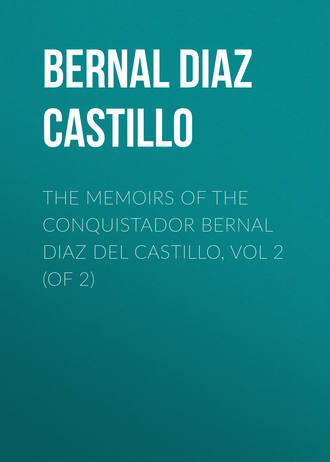
Bernal Diaz del Castillo
The Memoirs of the Conquistador Bernal Diaz del Castillo, Vol 2 (of 2)
CHAPTER CCXIII
Of the planets and signs in the heavens which prognosticated our arrival in New Spain; how these were interpreted by the Mexicans; and of other matters.
The Mexicans relate that, shortly before our arrival in New Spain, there appeared a figure in the heavens of a circular form, like a carriage wheel, the colours of which were a mixture of green and red. Shortly after a second, of a similar form, made its appearance, which moved towards the rising of the sun, and joined the first. Motecusuma, who at that time sat upon the throne of Mexico, assembled his priests and soothsayers, and desired them to watch, and explain to him these wonderful signs, which had never been seen before. The priests accordingly communicated with their god Huitzilopochtli, who answered, that they portended dreadful wars and horrible pestilence, and that it was necessary to sacrifice some human beings.
Shortly after these signs had been seen in the heavens we arrived in New Spain, and ten months after Narvaez came, and brought with him a negro, who was ill with the smallpox. From this person the disease spread among the inhabitants of Sempoalla, and thence, like a true pestilence, throughout the whole of New Spain.
When, subsequently, we fought the severe battles during the night of sorrows, and lost 550 of our men, who were either killed in our retreat or taken prisoners, and sacrificed to the Mexican idols, the interpretations which the priests had given of the signs were considered perfectly correct. These signs were not seen by any of us, but I have related this exactly as told by the Mexicans, for it is so described in their hieroglyphic writing, which we always found correct.
The following appearance I beheld with my own eyes, which any one else might have seen if he had taken the trouble of looking up. In the year 1527 there appeared in the heavens a sign, which had the shape of a long sword, and seemed as if it stood between the province of Panuco and the town of Tezcuco, and remained unchanged in the heavens for the space of twenty days. The Mexicans and their papas declared it was a sign of some pestilence, and certainly a few days after the measles, and another eruptive disease, like leprosy, broke out, which was accompanied by a very nauseous smell, and carried off numbers of persons, though it did not prove so destructive as the smallpox.
In the year 1528 a very heavy rain fell in Guacasualco, with large clods of earth. But this phenomena differed from what had been seen before of the kind, for as soon as these clods touched the ground they turned into innumerable frogs, a little larger in size than the bluebottle fly. The earth was completely covered with these creatures, which hopped about in various directions, to gain the river, which was not far off. As, however, there were myriads of them, and the sun burning hot, numbers of them perished before they could reach the water. The birds of prey certainly devoured great numbers, yet many of them still remained on the ground, and soon turned putrid, spreading a most dreadful stench around.
I have likewise been assured by credible persons that similar showers of frogs fell at Sempoalla, in the neighbourhood of the sugar mills, belonging to the accountant Albornoz.
I should not have noticed this raining of frogs if it were not something of rare occurrence, a thing which the greater part of mankind never see; moreover, celebrated men have said a writer should only notice those things which are truly wonderful. I was also assured by a cavalier of distinction, who resides in the neighbourhood of this town, named Juan de Guzman, that he himself was once caught in a shower of this kind, on his journey through Yucatan. He assured me that a number of such small frogs stuck frozen to his and his companions' cloaks, and they were even obliged to shake them off.
About the same time that this happened to Guzman, it also rained frogs in Guatimala, as I have been assured by my fellow-townsman Cosmo Roman. The most awful occurrence, however, took place in Guatimala, in the month of September, of the year 1541. Here a most terrific hurricane arose, accompanied by torrents of rain, which continued incessantly for the space of three days, and so vast was the quantity of water that came pouring down, that the crater of the volcano, which lies about four miles from the town of Guatimala, literally burst, and so terrific was the volume of water that came rolling down the mountain, that numbers of huge stones and trees were carried along with it. Those who did not witness it themselves will scarcely credit this, for there were masses of rock carried down by the flood which two oxen could not move, and these blocks of stone were left there as a memento of this fearful tempest. Every tree was torn up by the roots, and hurried down the precipices by the impetuosity of the torrent. The water had exactly the colour as if it had been mixed with chalk, and by the immense power of the hurricane it was raised into foaming billows. The noise occasioned by the rushing of the wind and water was so terrific, that persons could not hear each other speak, and fathers were unable to render their sons any assistance.
This direful tempest commenced at ten o'clock on Sunday evening, of the 11th of September, and the whole body of water, stones, and trees came rolling along over the half of the town of Guatimala, crumbling down the houses in its progress, strongly built as they were. A great number of men, women, and children perished in a few moments, and everything they possessed was lost. Some houses which had withstood the torrent were blocked up to the topmost windows by mud, pieces of rock, and large trees. During this tempest, also, Doña Beatriz de la Cueva, the wife of Pedro de Alvarado, perished, with several other ladies, who had fled to the chapel, to supplicate the Almighty in prayer to preserve them from destruction in the tempest. The water and mud rushed with such impetuosity into the chapel, that it soon gave way, and only three ladies escaped, one of whom was Alvarado's daughter; the names of the two others I have forgotten. This young lady, whose name was Leonora, was fortunately rescued from her perilous situation, between scattered trees and heaps of stone, and is now the wife of the distinguished cavalier Don Francisco de la Cueva, by whom she has several fine sons and daughters.
Many persons declared that they heard during this tempest a fearful kind of howling, yelling, and whistling, and maintained that numbers of evil spirits came rolling along with the large pieces of rock; for it would not have been possible for the water of itself to have moved those heavy masses of stone and large trees. In the midst of this flood people also said they saw a cow with one horn, and two monstrous-looking men, like negroes, with horrible countenances, who kept crying out in a loud voice: "Go on! Go on! For all must be destroyed!" If the inhabitants looked out of their doors or windows to watch the torrent, they were seized with such sudden dread, that they fled from their houses from one street to another, and were at length carried off by the flood, or sinking into the mud, were hurried with it into the neighbouring river. The Indians who lived further down the country, in the direction in which this mass of water, mud, stones, and trees was moving, fared much worse, for they were all drowned. May God have mercy on their souls!
I have above related that this dreadful tempest was looked upon as a punishment for the blasphemous expression which the disconsolate widow of Alvarado was said to have uttered at the intelligence of her husband's death. However, I have often been assured since I have resided in Guatimala, that this lady never gave utterance to the sinful expressions of which she has been accused, but that she merely said: "She wished she had perished with her husband."
I must not omit to observe that the stones which were rolled down with the flood are of such magnitude, that when any stranger comes to Guatimala, they are always pointed out to him, and he is quite astounded at the sight.
After this unfortunate occurrence the inhabitants burned all the dead bodies they could find; but they themselves durst no longer take up their abode in the town, and the greater part retired to their possessions in the country, or built huts in the fields. At length, however, they determined to build the present town, which now stands where formerly maise was grown. But I cannot say much in praise of the site that was chosen. It would have been much preferable if choice had been made of Petapa, or of the valley of Chimaltenango, both of which places are better situated for commerce. Each time the river overflows its banks the town is in danger, while earthquakes are of very frequent occurrence.65
After this destructive tempest, the late bishop, of pious memory, and several other cavaliers instituted an annual solemn procession, which was to take place on the 11th of September. This procession, composed of the clergy and of all the inhabitants of the town, set out from the principal church, under chant of sacred hymns, to the spot where the old town stood, and then entered the church, which on this day was decorated with green boughs and cloth, and a solemn funeral mass was performed for those who had perished in the tempest. After which funeral ornaments were placed on the graves of the more distinguished with lighted wax torches, and an offering was made of bread, meat, and other things, according to the quality of the person interred. After the funeral mass a sermon was preached, and the late bishop not only followed in the procession himself, but he likewise left a fund for celebrating the mass for the dead on the anniversary of this day of sorrows. After these religious ceremonies, those who formed the procession enjoyed themselves in the gardens and the fields of the neighbourhood, and feasted off the plentiful provisions which they had brought along with them, in the same manner as it is done in Spain on similar occasions.
What I have related of this deluge I have taken from the memorials of the late bishop, who was accustomed to note down every curious phenomena of nature which he himself witnessed in this neighbourhood; besides which, I have heard all this confirmed by eyewitnesses. But the procession I have been describing is no longer continued, as the fund left by the late bishop, according to the assurances of the priests and dignitaries of the church of Guatimala, is not sufficient to meet the expenses.



